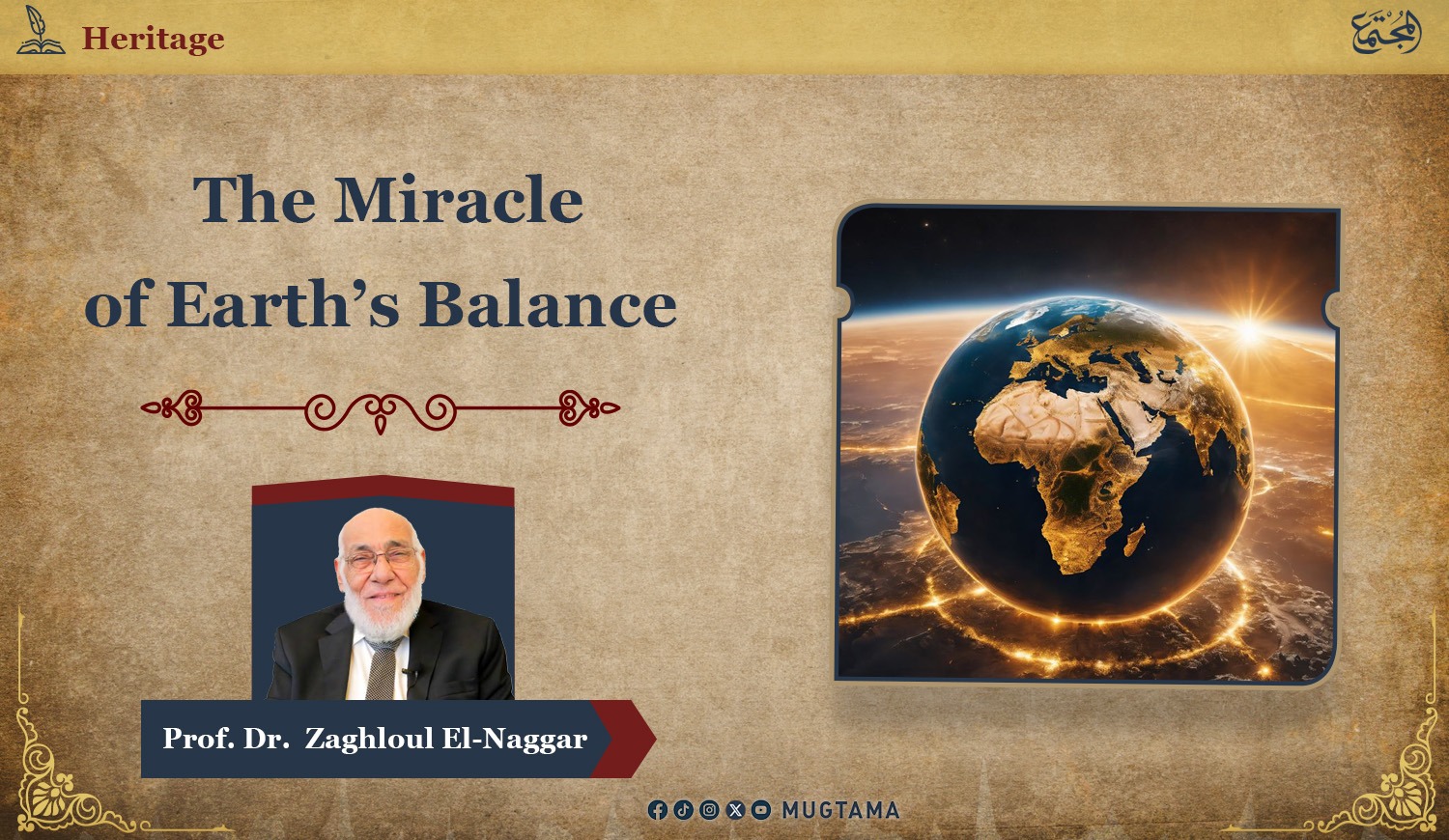The Miracle of Earth’s Balance

In the Name
of God, the Most Gracious, the Most Merciful.
{And He is the One Who created the
night and the day and the sun and the moon. Each [of them] is travelling in an
orbit.} (Al-Anbiya:
33)
God
Almighty speaks the truth.
The Earth
is but one of nine planets revolving around the Sun along with a number of moons,
asteroids, meteors, and comets to form a consistent group known as the Solar
System, connected to each other by fixed and permanent forces:
{Each [of them] is travelling in
an orbit.} (Al-Anbiya: 33).
And this Solar
System of ours is one of millions of solar systems that together form another precise
system, connected by tremendous gravitational forces, a precise kinetic system,
and fixed orbits.
This group
is known as the Galaxy. The galaxy that our Solar System belongs to appears in
the darkness of the sky as scattered white threads. Hence, the common Arabs in
ancient times called it “Sikkat Al-Tabbana” (The Straw Path), imagining that a
passerby over the blackness of this sky was carrying straw that scattered here
and there, leaving its white traces amidst the darkness of the sky.
Westerners
have recently named it the Milky
Way, stemming from the same concept.
Since the
distances between these celestial bodies—their suns, planets, and moons—are so
vast that they cannot be expressed by the human standards defined on the
surface of the Earth, such as the meter, the kilometer, the mile... etc., it
was incumbent upon scientists to devise other units for measuring such immense
distances. Hence, the light-year was conceived, which is the distance a ray of
light travels in one of our years at its known speed, estimated at about (300,000)
m per second.
That is,
the light-year =
(300,000 \times 60 \times 60 \times 24 \times
365)
This is a number that is almost difficult for
a human to express.
The closest
solar systems to ours is approximately 4.5 light-years away from us, while the closest
galaxy to us is (750) thousand light-years away. Glory be to the One Who said:
{So, I swear by the setting of the
stars, And indeed, it is an oath—if you only knew—tremendous.} (Al-Waqi’a: 75-76).
Star Clusters
After that,
there are millions of galaxies forming among themselves what is known as Local
Star Clusters, and then millions of these clusters to form larger
groups that man has not been able to fully verify, and the door remains open
for him to reach this path.
Above these
vast expanses that the human mind can barely comprehend, modern science proves
that these enormous groups are linked together by a precise, well-regulated
system, hurtling through cosmic space at a tremendous speed towards an end
known only to God, and that in this rush, they are continuously expanding.
Glory be to the One Who said:
{And the heaven We constructed
with might, and indeed We are [its] expander.}
(Adh-Dhariyat:
47).
A Suspended Ball Weighing (500) Billion Tons
After this
brief introduction about the Earth and its place in matter, we move to the Earth
and its matter. The Earth is a massive block of rock suspended in space,
weighing more than (500) billion tons. It is surrounded by an atmosphere that
is barely perceptible after forty km, although it reaches about one thousand km.
The areas of its verified depressions are covered by a layer of water that is
almost continuous, and various forms of plant and animal life live on its
surface, forming a distinctive biosphere.
The Four Spheres
Thus, the
Earth, with its four spheres:
- The Lithosphere
(Rock Sphere)
- The Hydrosphere (Water
Sphere)
- The Atmosphere (Air
Sphere)
- The Biosphere (Life
Sphere)
forms a miracle
beyond comprehension. The interrelation of these four spheres with one another
and with the Sun, the source of life, contains forms of miraculousness that no
statement can adequately describe. Plants absorb their nourishment from the
Earth's matter by means of the water that dissolves it. Then, they transform
these solid materials by means of sunlight, carbon dioxide from the air, and water
vapor from the air into simple proteins that the animal feeds on, turning them
into complex proteins from which it builds its body. Then, when we move to the water
cycle, the water evaporates in the seas, rises as clouds, then condenses as
rain that falls on the surface of the Earth, irrigating its plants and animals,
and then flows back to the seas and oceans again. Thus, it is an unending cycle.
Glory be to the One Who orchestrates it.
The Air Cycle: Another Miracle
Then there
is the air cycle. Humans and animals breathe oxygen and release carbon dioxide,
and plants breathe carbon dioxide and release oxygen. Thus, the ratios of the
different elements in this gaseous envelope are balanced in a way suitable for
life.
The Rock Cycle and Terrestrial Balance
Then the rock
cycle itself, which contains wonders that shake the soul. It suffices for one
to know that if the thickness of the rocks is measured from the center of the
Earth to the highest peak above its surface, and from the center of the Earth
to its deepest depressions, the weight of the rock column from the center of
the Earth to the base is perfectly equal in both cases. Were it not for this,
the Earth's rotation would not be stable, and enormous parts would be thrown
into cosmic space by the centrifugal force. Therefore, the Terrestrial Balance
is an astonishing matter, shaking the souls of the believers and showing every
living discerning mind that behind this universe is a Wise Creator God Who set
everything in it by measure and perfected everything He made.
The Surface and the Depth: An Unceasing Movement
Who can
imagine that whenever the factors of erosion eat away at a place on the surface
of the Earth's crust, a weight exactly equal to the amount of carried rock moves
within the Earth's interior to compensate for this depleted amount!
What After Solidification?
The rocks
on the Earth's surface are varied and numerous, but they are usually grouped
into three families. Regardless of the different theories explaining the origin
of the Earth, they all agree that its outer crust was, one day, in a state of molten
liquid that gradually began to cool. From this magma, massive crystalline rocks
free of life remains were formed, known as Primary or “Igneous” rocks. Then, by
being exposed to the various factors of erosion—such as winds, running water,
temperature variations, and the action of living organisms—these primary rocks disintegrate,
and their fragments are transported to the depressions of the Earth, where they
are deposited in the form of layers separated from each other by bedding planes
and are often distinguished by their content of life remains that were
flourishing in the aquatic environment in which they were deposited. These are
known as Sedimentary Rocks, relative to their method of formation.
More Pressure and Heat Create Metamorphosis!!
These
sedimentary rocks, or the primary igneous rocks, may be subjected to more
pressure and heat as a result of continuous deposition on them, causing their
level in the Earth's crust to sink. Thus, the pressure and heat increase, and
their components react again to give us secondary crystalline rocks known as Metamorphic
Rocks, relative to the fact that they result from a process of transformation
of previous rocks.
These
rocks, collectively, are essentially composed of minerals. A mineral is any
substance with a fixed chemical composition and a defined crystalline structure
that occurs in nature.
The Mineral: Gaseous, Liquid, and Solid
The mineral
is essentially composed of one element or a number of elements.
The elements
in the Earth's crust have been known to man for years. He has known the gaseous,
liquid, and solid among them; the light and the heavy; the easy and the not
easy; the malleable and ductile and the non-malleable/non-ductile; the conductor
of heat and electricity and the non-conductor; the one that rusts and the one
that does not rust.
He knew
that Hydrogen is the lightest of all, and that Uranium is the heaviest element
found in the Earth's crust so far!
He tried to
classify these elements and was amazed to find that they are arranged in groups
of eight that gradually increase in atomic weight, and later are united by specific
chemical and physical properties. Hence, the Periodic Table of Elements was
created with twelve periods, each containing eight slots, beginning with Hydrogen,
whose atomic weight was taken as a unit, and ending with Uranium, whose atomic
number is "92."
Unfilled Slots!
Man was
surprised by some "unfilled
slots" in this table. By a strange coincidence, these slots were
filled shortly after the table's creation. The newly discovered elements
perfectly matched the empty slots. Man was later able to add a number of
elements to these groups that were artificially created in laboratories,
although some of them are less stable.
The Nucleus: A Miniature Solar System
In an
attempt to explain the chemical and physical properties of elements, man
concluded that an element consists of molecules, and molecules consist of atoms.
The atom, as a whole, consists of a nucleus in the center carrying a positive
charge and a number of electrons orbiting it, carrying a negative charge. Thus,
it draws a miniature picture of the Solar System, but a picture of extreme
smallness. The nucleus in the center represents the sun of the system, and the electrons
around it represent the planets revolving in their place. The cosmic distances
in our solar system are scaled down to the maximum extent a human can imagine
in the atom, as the distances measured in light-years between star groups are
converted to distances measured by a new unit known as the "Angstrom"
of the millimeter, and the atom often does not exceed this Angstrom.
The Greatness of God... Between the Power of Magnification and the Power of Miniaturization
Here the greatness
of God in His creation is revealed:
One system,
no matter how minute in the atom, and no matter how immense in the cosmic
groups.
It is
astonishing that the amount of negative charge in the atom's electrons is exactly
equal to the number of positive charges in its nucleus. However, since the mass
of the atom is essentially concentrated in its nucleus, which represents most
of the atom's weight, it was necessary to conclude that there are other bodies
besides the negatively charged electrons and the positively charged protons.
These new particles must be electrically neutral, and hence they were named Neutrons
("the neutral ones").
Like Male and Female... The Proton and the Electron
It is
astonishing that this necessary neutron is, in fact, a union between a
positively charged proton and a negatively charged electron, hence its
neutrality. This indicates that the true unit of existence is the positive
proton and the negative electron, and they represent the male and female in
life groups. Their union represents the union between the sexes. They also
illustrate the grandeur of the universe in its largest form (its star clusters)
and its smallest form (the atom).
Atomic Synthesis and Hydrogen in a Furnace at (10) Million Degrees Celsius
It is
astonishing that modern studies prove that Hydrogen, the lightest element known
to all of us, constitutes more than (98%) of the total matter of the galaxy we
belong to, and perhaps in other galaxies, though we have no means to prove that
now.
Helium, the
"sun gas" first
identified in the Sun's outer envelope, is next in abundance to Hydrogen. This
observation inspired those who ponder the origin of the universe with an
astonishing idea: that Hydrogen is the origin from which all other elements
were formed. Just as heavy elements like Uranium decompose through radioactive
decay into lighter elements, it is possible for two hydrogen atoms to combine
to form a Helium atom with the release of enormous energy. This process was
named Atomic Synthesis to distinguish it from Atomic Decay.
It has been
proven that this process is currently taking place in the heart of the Sun
under high temperatures reaching ten million degrees Celsius. Through
mathematical calculations, it was estimated that hydrogen continues in this
chain of combination until it reaches the iron group at a temperature of (100)
million degrees, and so on.
A New Theory for the Origin of the Earth
Since these
high-temperature conditions are not currently known in our Sun or in the suns
of nearby groups, the theory of the Earth's origin, which advocated its
separation from the Sun, changed to a new theory that advocates that our Solar
System, at least, began with a cloud of Hydrogen that was at a very high
temperature. This led to the reaction of this Hydrogen to form Helium with the
release of enormous energy, and then the union of Helium to form the next
element in the periodic table, Lithium, and so on until we reached Uranium.
Here, the heterogeneity in the density of the formed molecules appeared in the
nature of this smoky cloud. The centrifugal force began to separate molecules
from it that flew away until they reached a point where the outward centrifugal
force was equal to the gravitational forces binding them to the original cloud.
They then stabilized in their place, rotated on their own axis, and launched
into another orbit around the original body. These bodies, known as primitive
planets, then began to cool gradually, forming the planets, asteroids, moons,
and comets that all revolved in fixed orbits around the original body, which
began to condense in the form of the Sun as a result of its temperature rising
due to continuous radioactive processes.
Uranium Formed Seven Billion Years Ago
It was
found that a specific isotope of Uranium spontaneously decomposes into an isotope
of Lead, and this rate of decomposition is constant regardless of the
surrounding physical and chemical conditions. Hence, those working in cosmic
studies concluded that if the ratio of the Lead isotope resulting from the
decomposition of Uranium in our Solar System is calculated, and this ratio is divided
by the annual rate of Uranium decomposition, it is possible to calculate the time
period that has passed since Uranium began to radiate and since the Uranium
element was first formed in our Solar
System. Through several experimental calculations, it was reached that Uranium
was first formed (7,000) million years ago. It is self-evident that other
elements were formed many years before that, which have not yet been
calculated. Therefore, the elements of the Earth's crust are estimated to be at
least (7,000) million years old. By calculating the time period required for
these elements to condense to form the Earth's rock material, it was found that
this took (2,000) million years. Hence, the estimates concluded that the Earth
took its form as a solid, rocky planet (5,000) million years ago. It was found
that the oldest trace of life in the rocks of the Earth's crust dates back to
an estimated age of (3,000) million years.
Life has
progressed from the simple and rare to the abundant and complex until the
picture was complete.
It was crowned
with the creation of Man, whose oldest confirmed trace on the surface of the
Earth does not exceed a quarter of a million years, although some scientists
extend it slightly more than that.
How Much Our Hearts Need to Reflect.
Here stands
the human being, whose average lifespan does not exceed (35) years in the best
of circumstances, standing astonished before an Earth that is (5,000) million
years old and upon a soil whose atoms were formed more than (7,000) million
years ago.
And his
tongue repeats:
{The creation of the heavens and earth is
greater than the creation of mankind, but most of the people do not know.} (Ghafir: 57).
Dr. Zaghloul El Naggar in brief:
- He obtained a Bachelor of
Science degree with Honors from Cairo University in (1955), and was first
in his class, for which the University awarded him the Mustafa Baraka
Prize for Geology for the same year.
- He then obtained a Ph.D.
degree in Philosophy in Geology from the University of Wales in Britain in
(1963), and the examining committee recommended that the thesis be
exchanged with universities around the world and published in its
entirety.
- The University of Wales
granted him a Fellowship Degree in (1963), and he also won the Robertson
Post-Doctoral Research Fellowship Degree later, and continued his research
on it from (1963) - (1967). This is the highest fellowship degree in
British universities and is awarded once every year to distinguished
scientists in various fields of pure and applied sciences.
- He has more than thirty
published and forthcoming papers in Britain, the United States, Denmark,
France, Switzerland, Germany, and Russia. The British Museum published one
of his works in a special commemorative issue of more than three hundred
pages and forty-one plates. This work was printed four times in English
and also translated into German and Russian, and was commented upon in
many international journals. The Geological Society of London awarded him
the prize for the best paper published in Britain in (1966) and the Murchison
Medal for the same year.
Likewise,
one of his research papers, published in the Journal of the American
Association of Petroleum Geologists, won the prize for the best paper published
in the journal in (1966). Dr. El Naggar has a new theory in stratigraphy
concerning methods of rock classification, and he has new classifications for
the Cretaceous and Tertiary periods. Dr. El Naggar represented Kuwait
University at the First International Conference on the Study of Planktonic
Life Remains, held in Geneva in September and October last, with two innovative
papers, and will also attend the First International Eocene Conference to be
held in Paris and the World Geological Congress to be held in Prague next
summer. Dr. El Naggar has worked at Ain Shams and Riyadh Universities, and the
University of Wales, and at the National Research Center in Cairo, the Phosphate
Mines in the Nile Valley, the Gold Mines in Al-Baramiyah, and the General
Authority for the Implementation of the Five-Year Industrial Program. He has
also carried out numerous technical consultations for oil exploration in the
North Sea, the Red Sea, and Dubai, and for groundwater exploration in Saudi
Arabia and Jordan.











